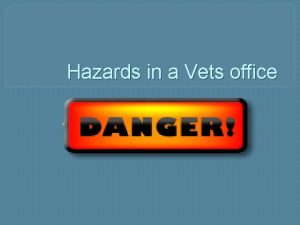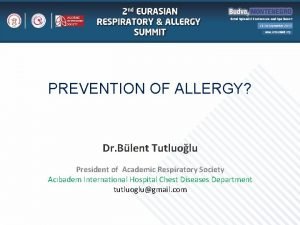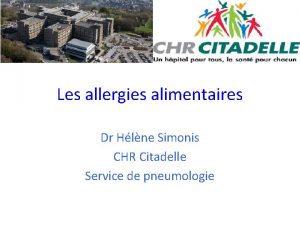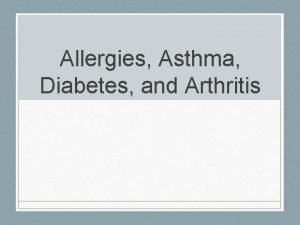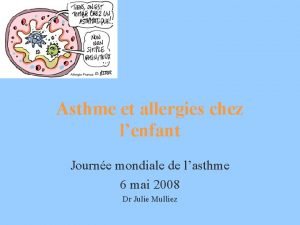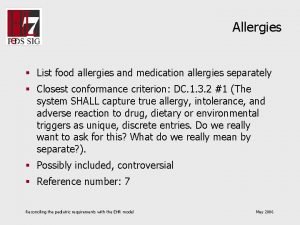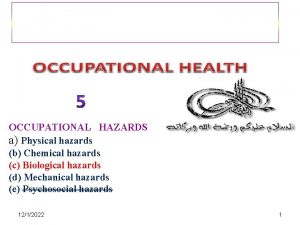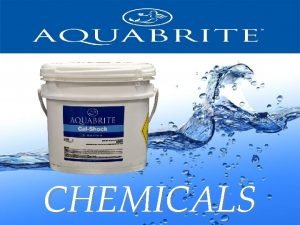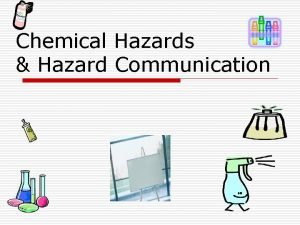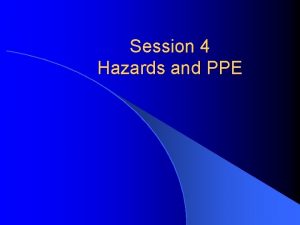Allergies Chemical Hazards Chemicals are part of the








- Slides: 8

Allergies & Chemical Hazards Chemicals are part of the foodservice environment

Allergies • Allergy> occurs when the body interprets a normally harmless protein as a dangerous substance. • An allergen is the misinterpreted protein. The body’s immune system then reacts against the allergen. These reactions range from skin irritations to difficulty breathing. In some instance, death. • Most people with food allergies have reactions to one or more of these allergens

Common food allergens • • • Dairy products Wheat products, including flour Fish Shellfish Peanut and peanut products Soy and soy products Eggs Seed like poppy, sunflower, and sesame Tree nuts like walnuts and almonds

Chemical Hazards • Chemical are part of the foodservice environment. In many cases, they aid the foodservice worker. • Chemical hazard>Any chemical that contaminates food. • There are many possible sources of chemical contamination in the kitchen. Certain metals found in cookware can become a chemical hazard. For instance, if copper leaches into food. Another metal is galvanized steel which contains zinc. • Food contaminated by chemical hazards also may be in the kitchen. Fish from polluted waters can contain unsafe levels of heavy metals such as mercury.

Chemical Hazards • Insecticides, pesticides, and herbicides may be found on thee exterior of fruits and vegetables. • Material safety data sheets> list the composition of chemical products, proper procedures for storage and handling, and what to do in the case of an emergency. All chemicals delivered to the professional kitchen come with MSDS.

Physical hazards • Physical Hazards> are solid materials that can pose a danger to the consumer when present in food. • Glass, staples, and part of a plastic bag, and toothpicks • Often, physical contamination is the result of carelessness. • Food for thought • Have you ever seen a person dip their glass into an ice bin and then fill it with a beverage? Hopefully never, but it happens. Aside from being unsanitary, it is very dangerous

Recap • Foodservice workers routinely use chemicals for cleaning and sanitizing the kitchen. Other possible sources of chemical include metals from cookware or the food supply, and agricultural chemicals. When these chemicals are ingested or come in contact with the food supply, they become a chemical hazard. • Physical hazards are solid materials that pose a danger for the consumer when present in food. Physical hazards are preventable by paying close attention to the food that is being served many physical hazards are visible.

Check your knowledge 1. List 3 common food allergens? 2. What is a chemical hazards and how can we prevent them inside of our kitchen? 3. What are physical Hazards and how can we prevent them inside of our kitchen? 4. Which of the following is it most important to store away from food? a) b) c) d) Seasoning Chemical sanitizing solution Beverages Napkins a) b) c) d) Keep it out where everyone can see it Tell everyone that it is in a new container Throw it away Label the new container clearly and store it properly 5. What should you do if you put a chemical into a container other than the one it came in?


